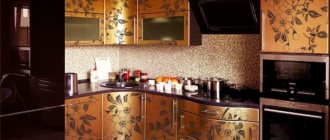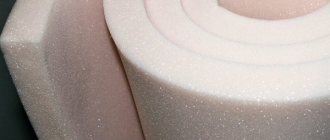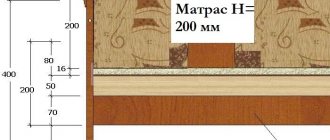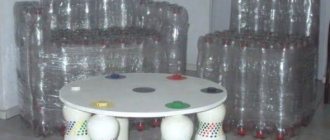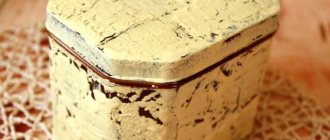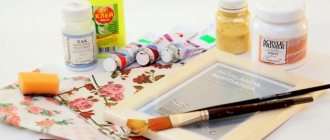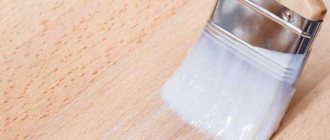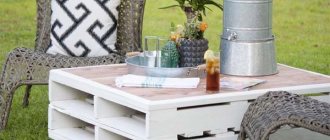Decoupage is a technique for decorating various objects by covering them with paper cut-outs, napkins, scraps of wallpaper and similar materials.
The decorated product is treated with varnish to preserve the coating. Decoupage of furniture using wallpaper has gained the most popularity today, and this is exactly what we will talk about in this article.
Making a work of art yourself from available materials
Peculiarities
Initially, this technique was used to decorate smooth glass and ceramic products. Therefore, its use as furniture decor has its own characteristics.
Interesting decoupage wallpaper from the inside
In general, the basic principles have not changed. So, its essence is to transfer the design to the surface using napkins. The original uses special napkins, ordinary paper, or thin paper, on which you can print any image you like. It is soaked a little, leaned against the glass, covered with several layers of solution (water with glue), then allowed to dry and varnished. The general principle is this. Now about the changes.
For any set, wallpaper is used instead of napkins. Moreover, not every type is suitable, and this technique is not suitable for every subject.
Simple decoupage of a closet with large pieces of wallpaper
What furniture can be decorated
Decoupage from the inside of the cabinet echoes the main color scheme of the room
There are a few rules to follow to avoid any unexpected surprises during the decor making process. It is desirable that the furniture be:
- varnished or sanded, because the paper will lie better on a flat surface;
- flat, this means that not the entire product can be decorated, but only some parts; creases and empty spaces can form on the bends;
- without damage, any chips, dents or other flaws will adversely affect the appearance and durability of the decor.
In general, any furniture can be decorated, but not all of its parts, and it must meet the criteria described above. Now all that remains is to choose the right material and get down to business.
What wallpaper to use
Wallpaper for decorating furniture using decoupage technique
There is a huge variety of wallpaper on the modern market: paper, non-woven, textile, vinyl, self-adhesive, silk-screen, etc. But not all of them are suitable for decoupage.
The first rule is that the base should be paper and easily soaked, so textile and silk-screen printing, not to mention liquid, fade into the background. The most commonly used are ordinary paper, vinyl, photo wallpaper and self-adhesive ones.
You can use the entire canvas with the selected print, or a separate part of it. Experimenting with small sizes is, of course, easier. But if you decide to decorate the cabinet door, you will have to work hard. Before we begin, we will select the appropriate type of equipment.
Decor for the back wall of shelving
A great way to decorate with wallpaper is to cover the back wall of open cabinets and shelving. Manufacturers of modern furniture almost never pay due attention to decorating interior surfaces. Agree, against such a background any souvenirs or dishes will seem festive and bright, and the furniture itself will sparkle with new colors. In this case, it is better to play with contrast and use wallpaper that differs from those with which the walls are covered. It is advisable to use wallpaper with patterns and patterns, especially for furniture with a light facade. By the way, you can take wallpaper that covers the walls in other rooms; this technique will help connect different rooms.
If the rack is divided into square or rectangular sections, then each can be covered with different wallpaper, again creating an analogue of patchwork.
Kinds
There are several options for performing decoupage. They vary depending on the base used.
- Classical
Elements for classic cut-out decoupage
Can be used for any plane. This method relies on first principles: a canvas with a pattern is applied, covered with water and glue, then varnish. Mainly paper and vinyl bases are used.
Decorating a cabinet using classic decoupage
- Art
Notebook cover made using artistic decoupage technique
The technique of execution is no different from the previous one. The only difference is that in this case, decoupage is part of an existing composition and must be adjusted to its laws.
Chest of drawers decorated using artistic decoupage technique
- Back
Decorating the tabletop on the reverse side using the reverse decoupage technique allows you to put anything on it without fear of scratching the varnish layer
Suitable for glass surfaces (cabinet doors). The operating procedure is the same as in the original technique. In this case, the creation does not need to be varnished.
Reverse decoupage is a good way to decorate glass furniture, allowing you to mask its minor defects
- Decopatch
Decopatch is a good way to update old furniture, because scraps of variegated paper can cover all defects.
A style similar to patchwork. They have one thematic basis: for decoration, the product is pasted over with various pieces of paper in a chaotic order. The method of execution is no different from the classic one, only the appearance and materials will differ.
Sideboard in ethnic style, decorated using decopatch technique
- Volume
Volumetric decoupage is the most interesting way of decorating
It contains admixtures of the “cutting” technique - creating three-dimensional paintings using paper. It is more difficult to implement, requires more materials, and is not suitable for every direction and product.
Volumetric decoupage of bedroom furniture
We will take as a basis the classic version using paper wallpaper, and consider the principles of doing the work.
Interior decor in drawers and behind doors
There is another technique for decorating furniture with wallpaper, which is used extremely rarely. If the decoration on the facade of the furniture complements the interior, then the decor of the interior space is intended solely to please the user. Wallpaper can be used to cover the inside of drawers of a cabinet or chest of drawers, the back surface of doors, including radius doors, as well as shelves and the inner wall of the cabinet behind the doors. You can first purchase wardrobe doors and then decorate them. In this case, the choice of pattern and color of wallpaper depends on your wardrobe and your own preferences, and the color of the walls in the interior does not play any significance here. Again, experiment with contrast. If you have a lot of monochromatic items in your wardrobe, choose wallpaper with flowers and ornaments; if colorful dresses and skirts predominate, stick on striped wallpaper.
Did you like the article? Subscribe to the channel to stay up to date with the most interesting materials
Source
Let's get down to business
Do-it-yourself decoupage of furniture with wallpaper is carried out in several stages. Each of them has its own significance, and none should be missed.
| Stage | Materials and tools | Result |
| Selection of materials | Paper wallpaper, PVA glue | Selected execution style, base with the image you like, additional tools |
| Surface preparation | Sandpaper, putty, solvent | All paint residues have been removed, the surface is smooth, treated with putty and ready for further decoration. |
| Taking measurements | Tape measure, stationery knife, pencil | Measurements of the working plane were taken, the material was cut off in accordance with the measurements |
| Main part | Image, PVA glue, water, roller | Wallpaper is applied to the surface, covered with a layer of water and glue solution, leveled |
| Open with varnish | Wood varnish, brush | The dried drawing is varnished |
Now you can look at the action plan in more detail.
Preparatory stage
We prepare the necessary tools and materials
At this stage, the main task is to choose the appropriate type of equipment, the wallpaper you like, and prepare all the necessary materials. It’s better to make a plan and write in it what you will need in the future - this will help you not to be distracted by purchasing various parts during the process, and to get the job done faster and with better quality.
It is also necessary to take measurements and, in accordance with the data obtained, cut off the appropriate amount of material. This is best done using measuring instruments. Since determining the distance “by eye” can have significant errors.
Do not forget about preparing the surface for subsequent work. It should be cleaned of dirt and paint residues, rubbed with sandpaper and covered with putty. Having completed these preparatory procedures, it will be easier for you to apply the image, and the decoupage will look great and last longer.
We clean and prepare the surfaces so that the surface is smooth and the design and varnish adhere well
Main part and final stage
We cut off a piece of wallpaper, make allowances of a few centimeters on the sides
In the direction of decoupage, the main role is played by preparatory procedures. If you approach them correctly, the main part will go quickly and easily. We have already selected the necessary wallpaper, taken measurements, and prepared the surface. Now it's a matter of small things.
Place the prepared image on the decoration area and smooth it out. Don't rush to start fixing. Choose the most convenient location, remove creases and irregularities. Now let's start covering. Pre-prepare a solution of water and glue (calculate the amount approximately based on the area). Make sure that the glue is completely dissolved and a homogeneous liquid is formed. To do this, it is better to use warm water (but not hot!).
Pour decoupage glue into a glass and treat the surfaces
Now carefully, using a brush, cover the entire drawing with this solution. It will be easier to work here than with napkins, since the wallpaper is denser and will not initially stick to the brush.
Carefully apply glue to the wallpaper
Apply several layers of solution until the material is slightly wet and pliable. Smooth the surface with a roller.
Carefully smooth the surface with a roller, removing unnecessary wrinkles
Let the product dry and move on to the final stage. Now all that remains is to varnish our creation. Before doing this, be sure to ensure that the image is completely dry. Otherwise, the varnish will not apply well, and mold may form underneath it later.
Lightly sand the edges of the table and apply a final protective layer of varnish
Decorative decoupage with wallpaper: master class
A decorative and beautiful look can be given not only to the closet. By choosing several patterns from one piece of wallpaper, you can decorate kitchen wooden stools. The technique is the same for all furniture.
You can find interesting ideas for decoupage of old furniture on the Internet.
You will need:
- Several cut-out wallpaper fragments;
- 4 wooden kitchen stools;
- PVA glue;
- Sandpaper;
- Water;
- Furniture glue;
- Alcohol;
- Paper towels;
- Textile;
- Primer and paint;
Sand the stools, removing excess paint and surface unevenness. Apply a coat of primer and paint. Soak the cut out wallpaper fragments in water. Apply glue to stools and wallpaper. Place the wallpaper fragments in the desired place on the stool, remove excess glue and reapply the glue in a thin layer for stronger adhesion. After the glue has dried, you can apply varnish or use a large-pore sponge to spread a little paint around the design.
You can complete the kitchen ensemble by decorating the doors of kitchen cabinets, window sills or countertops using the same technique and style.
Which style will highlight
Furniture decorated in this way is suitable for a limited number of styles. Because after this treatment it will have an aged appearance. Decoupage is also often used with various techniques that give the product an antique look. Thus, deliberately aged and shabby creations will take on Provence, vintage, retro, art deco.
Original decoupage cabinet in Provence style
Provence loves antiques, natural shades, various pieces of furniture and kitchen utensils. The latter can be decorated using the proposed technique. It is better to choose rustic motifs as a design: flowers, cockerels, chickens, images of the sun and herbs.
Beautiful chest of drawers after restoration in vintage style
Vintage things are the very charm. To decorate the interior, use various boxes and pieces of furniture processed using decoupage. To do this, use images of flowers, romantic silhouettes, and various plant motifs. Add some twine, burlap, white paint, and your perfect vintage design is ready.
Any type of furniture decoupage with wallpaper is perfect for a retro style. This trend will do well with aged items, especially if it is done with an exquisite method. Here you can use various lines, checkered prints and other retro motifs. It is better to choose dark colors.
This is how, with the help of decoupage, you can give old furniture a new life, give it a new original image, and create a new interior design.
Decoupage a coffee table with wallpaper under glass - quick and easy
Additional techniques for decorating furniture
Some tricks that can be applied after the decoupage itself will help you achieve a more sophisticated look for your decorated interior items.
- Craquelure is artificial aging, manifested in the form of cracks. Apply dark paint to the surface, which will become the color of the cracks (you can use gold or silver shades). After complete drying, cover the base layer with craquelure varnish. Apply paint of the main color to the partially or completely dried varnish, working quickly enough.
- Attrition is a faded area formed during the use of an item. Wax some areas and apply a coat of paint. After it has completely dried, treat the waxed areas with sandpaper.
- Patination is a partial darkening of the surface. Most often, dark, black, colored or metallic patina is applied to corners and other irregularities.
- Tinting is the application of colored spots by adding glitter or a minimal amount of paint to the varnish.
- Potal is the use of gold, silver or other metallic paint. It is most convenient to use gold leaf in liquid form, but it comes in the form of crumbs or a thin sheet.
Do-it-yourself furniture decoupage is a creative and exciting process. By watching the master class and building the correct sequence of applying each decorative element, you can achieve an incredible effect, giving the old set an updated look, sophistication, sophistication and uniqueness.

